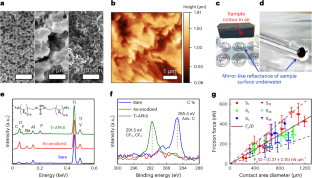2023-10-04 ハーバード大学
◆ハーバード大学を中心にした研究チームが、安定したプラストロンを持つ超撥水性表面を開発し、これが数ヶ月にわたって水中で持続できることを実現しました。この研究は、血液を撥水し、細菌や海洋生物の付着を大幅に減少または防止する長持ちする水中超撥水性表面の戦略を提供し、生命科学や産業分野でさまざまな応用が可能となります。
<関連情報>
- https://seas.harvard.edu/news/2023/10/staying-dry-months-underwater
- https://www.nature.com/articles/s41563-023-01670-6
水中における超撥水性表面の長期安定性 Long-term stability of aerophilic metallic surfaces underwater
Alexander B. Tesler,Stefan Kolle,Lucia H. Prado,Ingo Thievessen,David Böhringer,Matilda Backholm,Bhuvaneshwari Karunakaran,Heikki A. Nurmi,Mika Latikka,Lena Fischer,Shane Stafslien,Zoran M. Cenev,Jaakko V. I. Timonen,Mark Bruns,Anca Mazare,Ulrich Lohbauer,Sannakaisa Virtanen,Ben Fabry,Patrik Schmuki,Robin H. A. Ras,Joanna Aizenberg & Wolfgang H. Goldmann
Nature Materials Published:18 September 2023
DOI:https://doi.org/10.1038/s41563-023-01670-6

Abstract
Aerophilic surfaces immersed underwater trap films of air known as plastrons. Plastrons have typically been considered impractical for underwater engineering applications due to their metastable performance. Here, we describe aerophilic titanium alloy (Ti) surfaces with extended plastron lifetimes that are conserved for months underwater. Long-term stability is achieved by the formation of highly rough hierarchically structured surfaces via electrochemical anodization combined with a low-surface-energy coating produced by a fluorinated surfactant. Aerophilic Ti surfaces drastically reduce blood adhesion and, when submerged in water, prevent adhesion of bacteria and marine organisms such as barnacles and mussels. Overall, we demonstrate a general strategy to achieve the long-term stability of plastrons on aerophilic surfaces for previously unattainable underwater applications.



